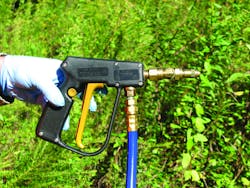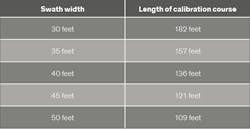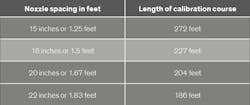Do your eyes gloss over at the mention of calibration? Sure, it’s tedious work, but it’s vital to being a good steward of both vegetation management budgets and the environment in which we work. Do it right and do it often, and you’ll extract the most value from every herbicide application.
That’s because, whether applied from a backpack or a boom sprayer, herbicides must hit their mark. Not just in terms of accuracy to avoid off-target damage to crops or other desirable vegetation, but also at the intended rates needed to achieve optimum control of unwanted vegetation.
Applying too little herbicide will likely result in poor control and may require a re-treatment, and applying too much wastes valuable resources. Apply way too much and a routine application can quickly become an off-label situation, according to Jerome Otto, integrated vegetation management market development specialist with Corteva Agriscience™.
“If you believe you are applying 30 gallons per acre but are actually only applying 15, you’re only using 50% of your target rate, meaning you’ll likely be disappointed with the results,” Otto says. “On the contrary, if you believe you are applying 30 but are really applying 60, you’re doubling herbicide costs. You may injure desirable grass species, and you could even be off label — which can all be very costly mistakes.”
Dialing in spray equipment at the start of the spray season, combined with regular recalibration during the spray season, helps avoid those scenarios. While it may seem complicated, following some simple guidelines and set math equations can help take the guesswork out of your next herbicide application and deliver the most return on your investment.
A how-to for dialing in backpack sprayers
Not all backpack sprayers need to be calibrated — for instance, if they’re being used to make low-volume basal bark treatments. Calibration becomes necessary when they’re being used in applications where a fixed broadcast rate per acre needs to be applied.
“Understanding some basic principles should allow anyone to easily calibrate any sprayer,” Otto says. “First, keep in mind that gallons per acre of spray solution will determine how many acres will be applied per spray tank. Once you know this, you know how much herbicide to add to the tank.”
Remember that 1 gallon is equal to 128 fluid ounces. Therefore, the calibration spray area should be sized to 1/128 of an acre. This will ensure the fluid ounces collected during calibration equate to gallons per acre.
To start, make sure the sprayer and nozzle are clean and fill the tank with clean water. Spray some water on a surface to ensure the nozzle is working properly, then select a spray tip that provides a uniform pattern for the area you are treating. Measure out an area of 18.5-by-18.5 feet, or 1/128 of an acre, in a field where the spray will be applied. Time the number of seconds it takes to spray the measured area uniformly by using a gentle, side-to-side sweeping motion with the spray wand. Repeat this step and average the two times.
Maintaining a constant sprayer pressure, spray into a container for the average time just calculated and measure the material in the container. This number is in fluid ounces and is equivalent to the number of gallons per acre the sprayer is delivering. For example, if 30 fluid ounces of water is collected in the container, the sprayer will deliver herbicide solution at a rate of 30 gallons per acre. It’s that simple.
Setting up boomless sprayers for success
Boomless sprayers are often selected for use when application terrain is rough, and using a boom with evenly spaced nozzles will be ineffective. When setting up a boomless sprayer, it’s critical to keep pressure and speed constant, so determine the pressure you’ll be spraying that day as well as the desired speed the sprayer will be traveling.
“The first step is determining the gallons per acre being sprayed,” Otto says. “Instead of driving the entire distance it would take to determine gallons sprayed per acre, it’s easier to drive 1/8 that amount to collect pints per acre and then convert it back to gallons, remembering that there are 8 pints per gallon.”
One-eighth of an acre is 5,460 square feet. Understanding that area is equal to length multiplied by width, a simple chart can be developed showing how long one must travel to achieve 1/8 of an acre with a given swath width.
Once the length of the calibration course is determined, drive that distance in the gear and rpm that will be used during spraying. Record time in seconds, then repeat and use the average of the two times. Park the sprayer and maintain the same rpm. Turn on the spray and collect the water for exactly the same number of seconds required to drive the calibration course. The amount of pints caught is equal to the gallons per acre the sprayer is putting out.
The easy way to calibrate boom sprayers
Just as with boomless sprayers, setting up boom sprayers requires keeping both pressure and speed constant. Otto lists a couple important things to keep in mind.
“First, take the square feet in an acre — 43,560 — and divide it by the number of ounces in a gallon — 128,” Otto says. “Then, determine the distance between your nozzles in feet. Finally, take 340 divided by the nozzle length in feet to determine the length of the calibration course.”
The chart below demonstrates some common setups.
Next, measure and stake off the appropriate calibration course based on nozzle spacing, and make sure to conduct the calibration run on the same type of terrain as you’ll be spraying later.
Drive the course in the gear and at the rpm that will be used when actually spraying. Record the time in seconds. Do this twice and use the average of the two tests. Park the spray rig and maintain the same rpm. Turn on the sprayer and catch the water from one nozzle for exactly the same number of seconds it took to drive the calibration course. Ounces caught is equal to gallons per acre. Be sure to check all nozzles to ensure that flow rate doesn’t vary by more than 10%.
For example, assume nozzles are spaced at 1.5 feet and it takes an average of 30 seconds to drive the course (227 feet) at 5 mph. Let’s also assume that 20 ounces of water are collected when the sprayer is parked and the nozzles are turned on for 30 seconds. In this case, the rate being applied is 20 gallons per acre.
Regardless of the type of sprayer, Otto reiterates that taking the time to calibrate it pays dividends.
“You’ll get optimum control of targeted vegetation without wasting product, which helps you get the most value from herbicide purchases,” he says.
Sponsored by:
™®Trademarks of Dow AgroSciences, DuPont or Pioneer, and their affiliated companies or their respective owners.
©2019 Corteva Agriscience



